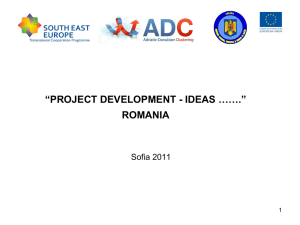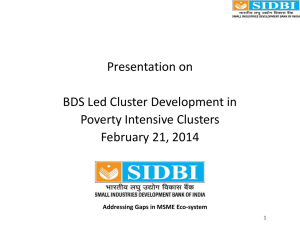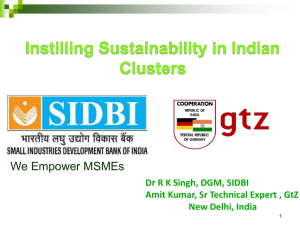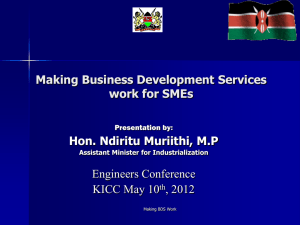Corporate Bond Market - Recommendations
advertisement
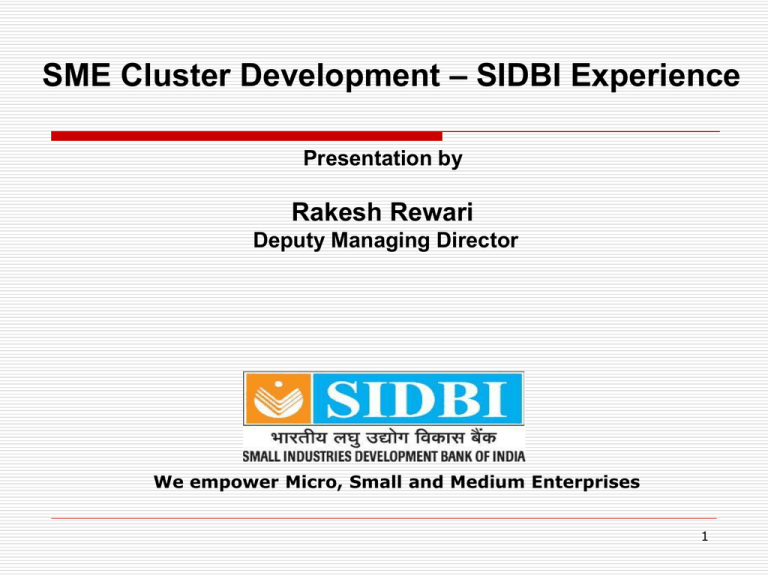
SME Cluster Development – SIDBI Experience Presentation by Rakesh Rewari Deputy Managing Director We empower Micro, Small and Medium Enterprises 1 Indian SME Sector – An Overview The SME sector a strong pillar of Indian Economy Contribution to Economic Growth, Poverty Reduction, employment creation • No. of SMEs – 29 million units o 95% micro enterprises • Second largest source of employment- 66 million • Contributes 45% of industrial output and 33% of exports 2 SME Clusters in India In India, more than 6,500 MSME clusters : • 6,000 Artisans / Micro Clusters • 700 SME Clusters, out of which 300 modern clusters. Wide range of clusters from artisan/traditional to modern/high tech • Artisan - Leather, Woolen knit wears, Glass ware and Bangles etc. • Modern /High tech - Machine Tools, Auto components etc In some urban clusters, Growth unplanned. 3 Challenges of SME Clusters Impact of Globalization and global crisis Subsidy / concessional financing being phased out High risk of SMEs – banks’ perception Technology, Marketing, manpower challenges Common facilities – issues Environmental issues of cluster in urban areas Limited implementing agencies/BDS providers in the private sector 4 Cluster Development – Advantages for Bankers Identification mitigation. of common risk elements and their Greater outreach with single financial product. Standardization transaction cost. of documentation – reduction of Easy monitoring and follow-up. Better information and inter-firm comparison. 5 Cluster Development - Key role by Government MSE Cluster Development Programme • Soft Intervention – training programme, skill development • Hard Intervention - 75-90% grant for infrastructure projects or development of common facilities Scheme of Fund for Regeneration of Traditional Industries (SFURTI) • development of traditional/artisan clusters like khadi, village or coir industries Industrial Infrastructure Up-gradation Scheme – • development of physical, technological, R&D Infrastructure in cluster. 6 Cluster Development by SIDBI – Guiding Principles Increase competitiveness of clusters Support Common facility, new technology, skill upgradation, common brands, joint marketing. To ensure high replicability and dissemination potential. Introduce international best practices. 7 Financial – Business driven Facilitating greater flow of credit to clusters MoU with banks for Joint / co-financing of projects in identified clusters Financing in clusters through MoU with SME Industry Associations • FSIA – Pre-approved limits to members for unforeseen business related Expenses. Thrust on Energy Efficiency in Clusters. Partnership with World Bank & Government of India to finance energy efficient measures/technologies in 75 clusters. Concessional loans for clean production measures, common effluent plants, renewable energy in targeted clusters. Financial – Business driven Facilitating greater flow of credit to clusters Introduced a “ Green Loan Scheme” to provide concessional loans to environmentally sustainable facilities/services with cluster focus. Environment friendly measures through linkages – assistance to Mumbai Taxi owners to replace old taxis with CNG taxis, financing of LPG auto rickshaws in Chandigarh, Solar Lantern in North-Eastern India. Financial – Business driven Financing infrastructure in cluster • Financing for market development • Supported setting Coimbatore • Supported KASSIA for setting up of permanent trade fair and display center up of permanent trade fair in Developing CDM / carbon credit • Development and financing of textile park in Tirupur Financing credit support to SMEs in Jodhpur steel rerolling cluster to implement measures for CDM Developed a faster credit delivery model ( CART) and shared with banks/FIs Developmental – Activity-based SIDBI supported : • Support to Jamnagar Association to set testing lab • Rajkot – Development of cluster website and SPV for foundry cluster on PPP mode • Capacity Building in the areas like Skill upgradation, entrepreneurship development, financial management etc. • Kanpur –Skill upgradation for product improvement Developmental – Activity-based Skill Development • 12 skill development centers has been established, 21 linked up / institutionalized and 4 others are likely to be setup soon. • Wages of women artisans increased > 3 times • Skill efficiency increased by 10-15% Walk-through energy audits • Energy Efficiency increased by > 15% Sick/closed CFCs activated • Now profitably running, benefited more than 1000 SMEs. Developmental – Activity-based Rural Cluster Development • Rural Industries Programme for development of viable and self-sustaining tiny/small enterprises in rural India by harnessing local entrepreneurial talent. • To address the problems such as rural unemployment, better commercial exploitation of the local resources and addressing the problem of urban migration. • • Designed as a comprehensive Business Development Services programme. Ultimately linked to bank finance. Implemented in more than 100 districts in 24 states Cumulatively, almost 30,600 units promoted; Employment generation of more than one lakh persons. BDS in SME Clusters MSME Financing and Development Project (MSMEFDP) A World Bank led project called MSME Financing and Development Project (MSMEFDP). BDS in 26 clusters in the areas of new technologies, use of IT, skill development, energy efficiency, marketing, etc. Supported SMERA to develop Green Ratings, first time in the country – starting with a Foundry Cluster. Micro Enterprises Business Information Counselors (MEBIC) • Provided services to 755 prospective entrepreneurs Capacity building of Industry Associations for greater credit flow. msmementor.in- A national level database of BDS provider to mentor, handhold and provide expert services to MSMEs. Organising BDS clinic, BDS Bazar, Exposure visits, etc. Lessons Learnt Credit with hand holding required Govt plays key role for support services Identify local agencies for implementation Strategy for each cluster may be different For quick success look at leaders in clusters. Integrated approach Associations Long haul - Be prepared to finding fine tuning strategy. Publicize success stories, best practices Intervention schemes should be simple, easy to understand. by Govt., Banks, BDS providers, THANK YOU We empower MSMEs 16




